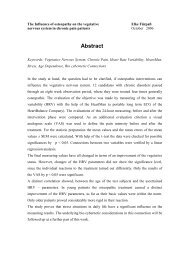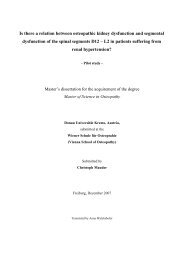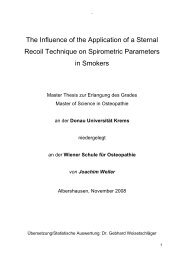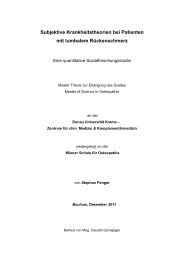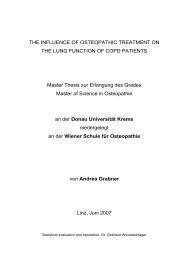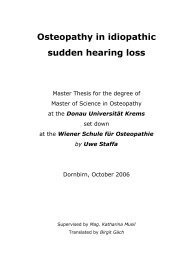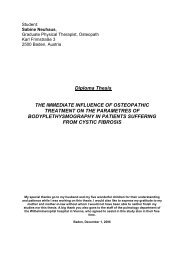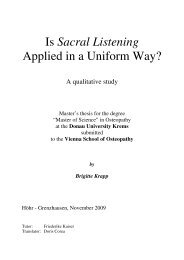Can back pain caused by symptom-giving sacroiliac joint relaxation ...
Can back pain caused by symptom-giving sacroiliac joint relaxation ...
Can back pain caused by symptom-giving sacroiliac joint relaxation ...
Create successful ePaper yourself
Turn your PDF publications into a flip-book with our unique Google optimized e-Paper software.
1.3.4. Symptom-<strong>giving</strong> pelvic girdle <strong>relaxation</strong> (PGR)<br />
This concept is largely used in the Scandinavian region. It does not specify which<br />
<strong>joint</strong>s are concerned. [17, 2, 37, 57]<br />
Symptom-<strong>giving</strong> pelvic girdle <strong>relaxation</strong> is defined as a condition developing during<br />
pregnancy or delivery and is characterized <strong>by</strong> disabling <strong>pain</strong> located to the SIJs<br />
and/or the pubic symphysis. No objective criteria exist to confirm the diagnosis which<br />
is therefore one of exclusion. [29 p.105]<br />
PGR can start to show in the first trimester; however, normally it does not occur<br />
before the fifth to eighth month of pregnancy. In most cases the <strong>symptom</strong>s disappear<br />
immediately after delivery, while in some cases the problems last for several more<br />
months. [29]<br />
The study of Larsen (1999) [29] shows an incidence of 14 % during pregnancy for<br />
PGR, and 4 % still have problems during six more months after pregnancy, which are<br />
then called "pelvic <strong>joint</strong> syndrome".<br />
1.3.5. Pelvic <strong>joint</strong> syndrome (PJS)<br />
PJS often occurs after delivery as a consequence of PGR during pregnancy. Women<br />
with PJS suffer from constant and daily <strong>pain</strong> episodes located to the pelvis and<br />
symphysis pubis. The <strong>pain</strong> varies in intensity and strength and is enhanced <strong>by</strong><br />
walking, when lifting light loads and when changing position. The <strong>pain</strong> in the <strong>joint</strong>s is<br />
very often accompanied <strong>by</strong> uncharacteristic radiating <strong>pain</strong> to the gluteal region and<br />
thigh. The diagnosis is based on medical history. Thus, no objective criteria exist to<br />
confirm the condition. [17 p.170]<br />
Master’s Thesis Wolfgang Aspalter 23



